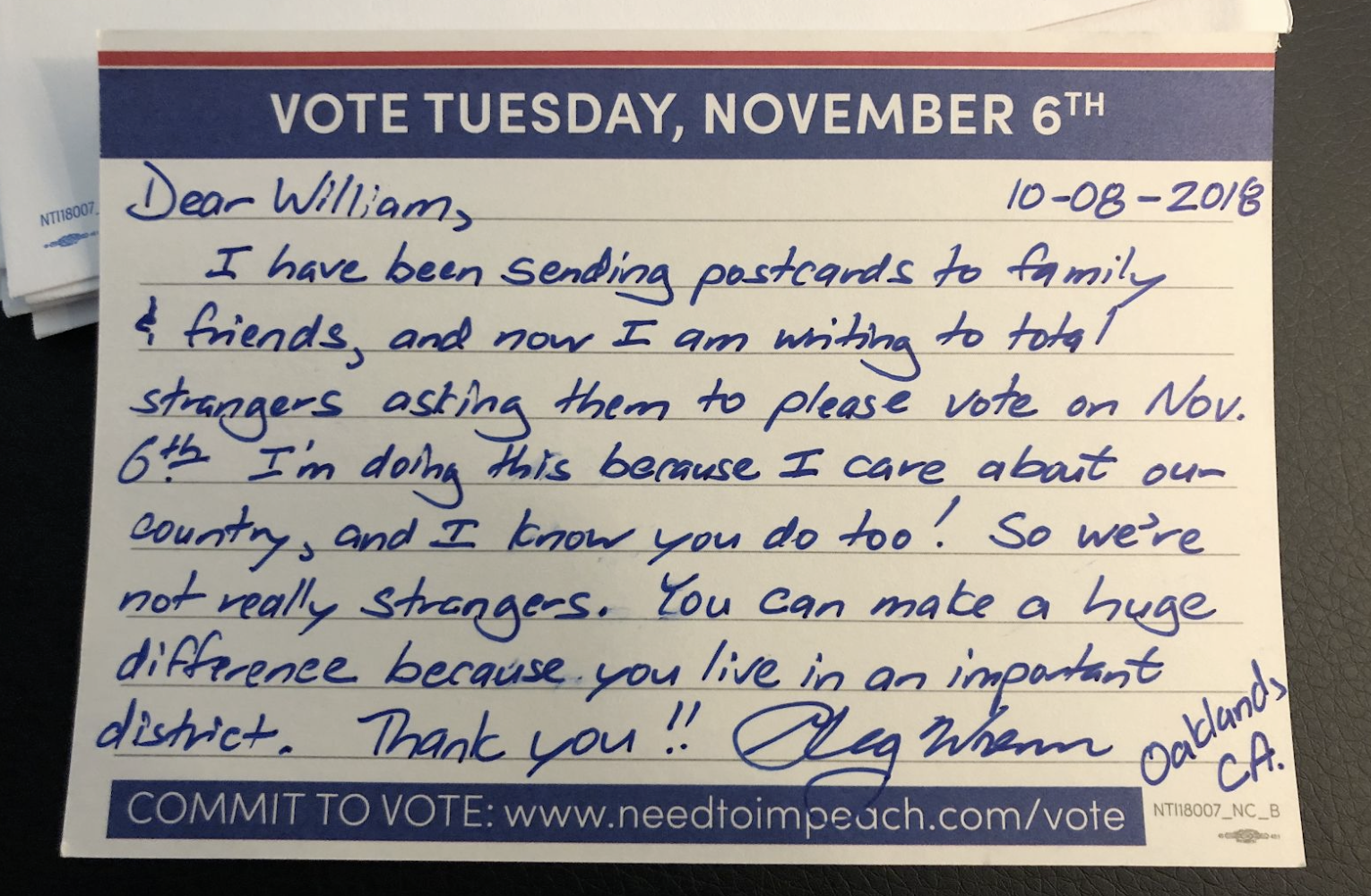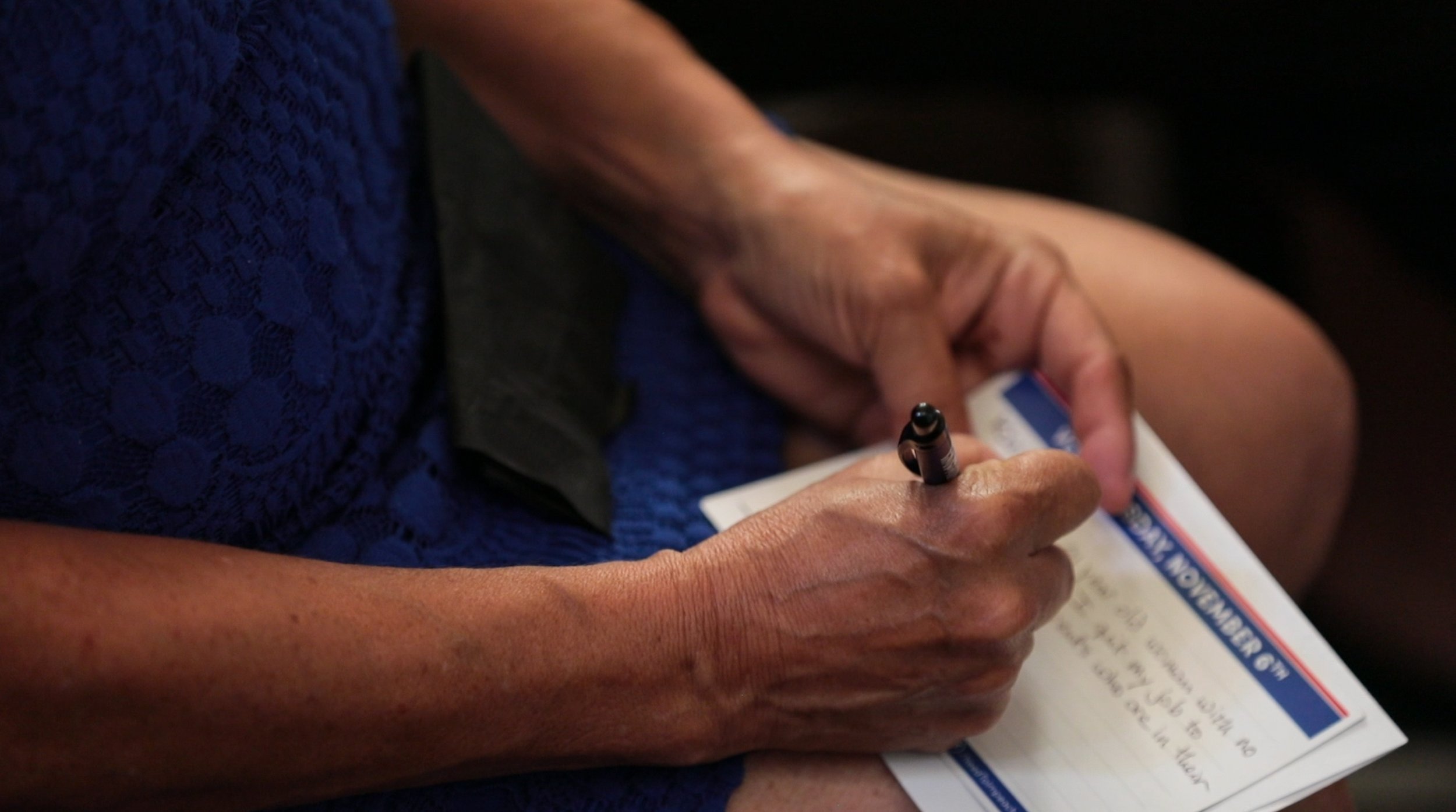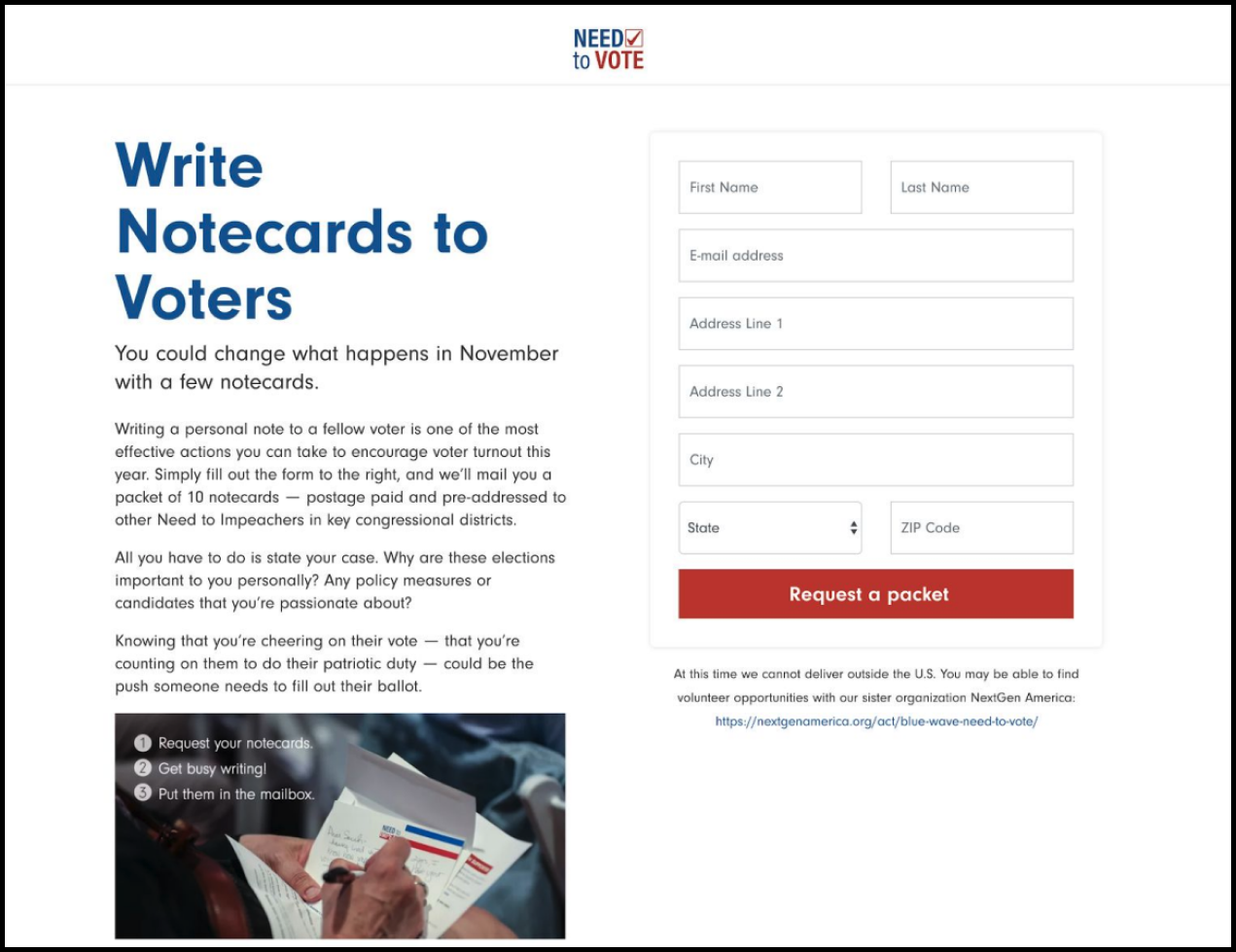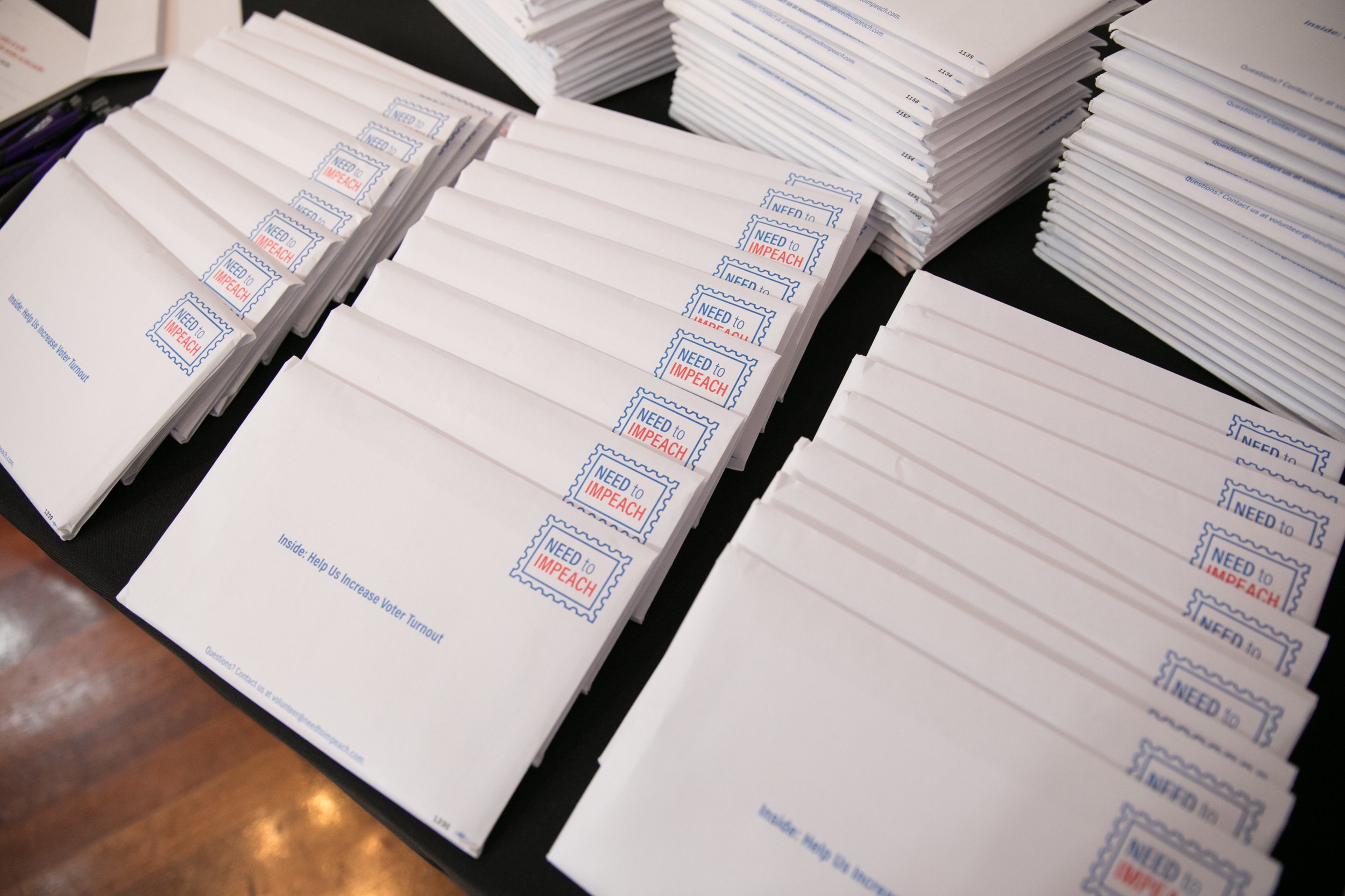Need to Vote - Connecting voters nationwide leads to historic turnout
The Need to Vote program began with an idea and a research question about the effectiveness of peer-to-peer communication in motivating people to vote.
MY ROLE: Program Manager, User Researcher
DURATION: 3 Months; Aug 2018-Nov 2018
KEY SKILLS: User Interviews, Survey Design, Quantitative & Qualitative Analysis, Program Strategy, UX/UI Design, Leadership/Team Management, Onboarding System Design
IMPACT MEASUREMENT METHODS:
Quantitative: Number of notecard writers, number of notecards sent & delivered, Percentage increase in voter turnout. Qualitative: Both notecard writer and recipient user feedback
MEDIUMS:
Physical: VOTE Notecards & Notecard Packets; Digital: Customized Volunteer Election Center Website for Notecard Tracking & Engagement, USPS Data Tracking System


Background
Tom Steyer launched the Need to Impeach digital campaign in 2017 with the goal of gathering support to remove Donald Trump from office and turn out voters for the 2018 midterm election. Many tactics, both digital and physical, were designed and used to mobilize supporters to connect with and motivate infrequent midterm voters in 43 key districts. The Need to Vote program’s initial goals were to set up a digital system for volunteers to sign up, order and send 500,000 handwritten notecards before the election and a way for our team to measure receipt, voter commitment and eventual turnout.
The NTI digital team was quite large but my smaller team working on the Need to Vote program consisted of myself, my boss (engineer), a data engineer, two web developers and two junior project managers. As a team we built, launched and grew this program, exceeding our original goals (keep reading to learn more) and having the largest impact on voter turnout of all campaign tactics.
Research Question
How effective are handwritten notecards in energizing members in battleground congressional districts to vote in the 2018 midterms?
Assumption & Hypotheses
Receiving a postcard has a positive effect on turnout, and two notecards are better than one.
Receiving a notecard is impactful
The more notecards, the higher the impact
Notecards will show the most impact on low propensity voters
Increases in activism among notecard writes post election
Methodology
Secondary Research
Reviewed GOTV studies related to relational organizing and voter turnout tactics to inform our research and program strategy and design.
Primary Research
Small scale in-person events, in different states, were used to test attendee interest in notecard writing. Notecards were provided for people to write and send. There was an overwhelming demand for participation across all events, which led to the expansion of our research, design and development of the digital program.
A selection of first adopters of the program and volunteers who participated regularly, were asked to complete surveys and remote interviews throughout the program’s existence. We also ran usability tests when launching the customized digital volunteer web portal.

The first step in the program was to understand how many NTI supporters were interested in receiving notecard packets to write and mail (all notecards were prepaid) to voters. We sent an email to everyone who had signed up online for the Need to Impeach campaign, which at this stage was a couple million, requesting volunteers for notecard writing. The number of responses was exciting, but overwhelming. This gave us the information we needed to begin design and development for version 1.0 .
I learned who our users were and how they were willing to participate as they continued to take action. I reviewed the data we had about their engagement online and set up surveys and interviews to better understand their behaviors and desires to inform our design process.
Identifying Users
The Need to Vote program wouldn’t work or even exist without volunteers.
Volunteer: An individual who has requested and completed at least one packet (10 notecards) of notecards. They’re interested in taking action but don’t want to work too hard to complete a task.
Activist: An individual who has requested and completed more than one packet of notecards. They eventually make writing GOTV notecards into a group activity and host writing events. They are also willing to complete additional actions such as calling a representative or attending a rally.
Notecard Recipient (voter): An infrequent midterm voter living in a key district who has received a handwritten notecard from a volunteer. They don’t normally vote during midterm elections.*
*Voter data came from each state’s voterfile.

Need to Vote Website: Sign Up Form

Notecard Packets
Design and Development
We quickly learned that we would need to design a smart system for the 78,650 volunteers who signed up to write notecards. We wanted to make sure users could easily find a way to request more packets and track their impact, while building and utilizing a database for tracking relationships between volunteers, voters and notecards. These are the core digital tools we designed and built:
Need to Vote Website
Allowed volunteers to fill out a form to request packets of notecards with prepaid envelopes addressed to voters living in key districts. A single packet of 10 notecards and envelopes with instructions got sent to the volunteer to complete and put in the mail.
Volunteer, Voter & Notecard Data Tracking System
Each notecard had a unique USPS barcode and each packet had a unique ID. Once a volunteer signed up for a notecard packet(s), the ID of the packet got assigned to their profile in our database. When a volunteer dropped the notecards in the mail and the barcodes were scanned, our system was updated with a [mailed] tag and when the card was delivered the [received] tag was applied. Using this data we were were able to:
Match the volunteer to the voters on the notecards
Measure if a voter received 0,1,2 or 3 notecards
Track when cards are mailed/delivered
Build a custom volunteer dashboard and action center to track and take action
Personalized Volunteer Action Center
A personalized digital dashboard for volunteers to login, request more notecard packets, see their writing progress and nationwide impact, share with friends and take new volunteer actions locally.
User Support Experience
We needed a system to communicate with and provide support to all volunteers. Intercom gave us the ability to create custom onboarding flows and automated email series while building out the profiles of each user. We were able to address issues, concerns and any feedback users had while interacting with our tools.
Commit to Vote
Once a notecard was delivered, the recipient received an email within 24 hours with the option to respond or leave a personal note to their sender (digitally), as well as an option to commit to vote. If the voter commits to vote, we stored that data in our system and assigned the commit to the volunteer who wrote the notecard. Their personalized action center would then update to reflect the number of voters who had committed to turnout due to their personal note.
Iterate
The program grew very quickly, requiring us to be constantly iterating on our tools to make sure we were meeting users needs and the tight election timeline. We achieved this by working together as a team to identify needs and issues, respond, build, test, ship and repeat on a week to week basis. Our work was a direct result of listening to our users and designing a system that was easily accessible, approachable and personal.
Impact & Key Takeaways
By election day 78,650 members had been activated to send over 1.6M notecards and volunteers completed over 1.2M volunteer actions from texting and phone calls to hosting house parties. Member-to-member handwritten notecards proved to have the biggest impact on turnout nationwide. NTI signers that were sent one, two, or three handwritten notecards turned out at rates that were 3.96 percentage points higher than turnout among comparable NTI signers that were not sent a handwritten notecard.
Qualitative Survey Findings
We had 2,465 responses to our post election survey sent to volunteers or notecard writers.
72.4% were first time participants in a program like this
81.3% would participate again
96.8% had a positive experience
68.8% Felt empowered
76.1% Felt the most important part of the program was voter to voter communication
95.5% Felt they had an impact
We had 1,020 responses to our post election survey sent to known notecard recipients.
78.4% enjoyed receiving a notecard
45% would write notecards to voters next election
50% would be interested in getting involved in other ways
Handwritten notecards and voter-to-voter communication seemed to motivate individuals to connect on important issues. The evidence suggests a positive impact when a program provides people with the tools to contribute to change, and the ability to connect on a personal level with fellow Americans.
Best practices for scaling this program in the future would be to better account for the USPS process and inevitable system delays and tracking errors, expand production of notecards to meet a higher demand than anticipated and think about systems to enable volunteers to work and organize together more often since the personal connection part of this program proved to be so valuable.
